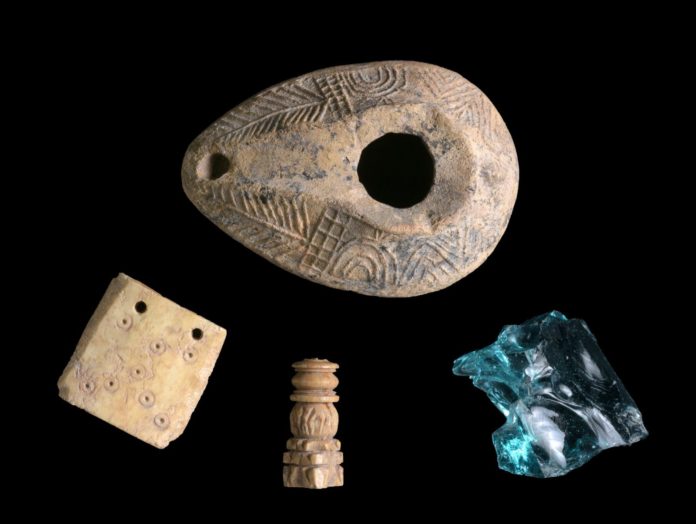Rare Menorah, Coin, Found in Galilee Archaeological Dig
Written by Mara Vigevani/TPS on April 16, 2018
A group of high school students discovered a 1,400-year-old intact oil lamp bearing the symbol of a menorah during an excavation at the Horbat Usha archaeological site in the Lower Galilee, the Israel Antiquities Authority said Monday.
The lamp, which was unearthed in March, probably dates from the Byzantine or Umayyad period. Together with the lamp, the students also uncovered evidence of the glass industry from the time of the Sanhedrin and a gold coin bearing an inscription of Sultan Suleiman the Magnificent, the 16th Century builder of Jerusalem’s city walls.
Usha is where the Sanhedrin first relocated after the Bar Kokhba revolt, the 2nd Century uprising against the Romans, and where Rabbi Yehudah HaNasi, codifier of the Mishnah, spent his childhood. After the Sanhedrin settled in Usha, it moved to Shefar’am, Bet Shearim and Zippori, until it was finally established in Tiberias.
Yair Amitzur, an Israeli Antiquities Authority archaeologist, believes the lamp was owned by a descendant of one the rabbis appointed to sit on the Sanhedrin, who was most likely a resident of Usha.
“The lamp dates from a period after the Sanhedrin. It probably was an object passed from generation to generation,” Amitzur told Tazpit Press Service (TPS).
Regarding the coin, Amitzur said is of particular interest as “only other two coins of this kind exist in the State Treasures.”
According to Amitzur, nobody lived in Usha at the time the coin was minted, and thus was most likely lost by someone passing through the area.
According to Einat Ambar-Armon, an IAA archeologist and an expert on ancient clay lamps, the lamp is particularly interesting because the menorah engraved on it has eight branches, and not seven like the Temple menorah. The lamp also has a three-legged base, another unusual feature.
“ The discovery of a lamp decorated with a menorah, a symbol of the Jewish people, is without a doubt exciting, especially at a site with such a unique heritage in part of the Sanhedrin Trail,” she said
The students made the discoveries while participating in preparing the interactive “Sanhedrin Trail,” a smart trail in which dozens of stones will transmit information and activities to hikers’ mobile telephones. As part of the project, the students took an active part in archeological excavations.
The trail, covering a distance of 70 kilometers, is divided into sections and traces the movements of the Sanhedrin sages crossing the Galilee from Beit Shearim to Tiberias. The trail will be officially inaugurated on April 22, just after Israel celebrates 70 years of independence.
The trail was initiated by the Israel Antiquities Authority in cooperation with the National Religious Education Administration of the Ministry of Education and is financed by the Landmarks Project of the Ministry of Jerusalem and Heritage. Regional councils and towns along the route, as well as environmental organizations, are partnering in the effort.
Israel Hasson, director of the Israel Antiquities Authority, said the discoveries along the trail are a gift to the State of Israel from thousands of young people who invested so much of their energy in developing it.
“The trail is a groundbreaking endeavor utilizing state-of-the-art technologies to connect with our roots. The project will be further developed in the coming years, creating continuity from the distant past to the future, which will be used by hikers in Israel today and, hopefully, future generations as well,” he said.
Photo by Yaniv Berman, IAA on April 16, 2018






